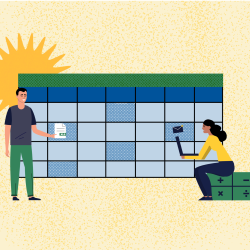DIIMP Dishes On Growing Healthy Teams

Can a good spreadsheet make you cry?
According to Lori Nauden, the answer is yes.
A Budget Analyst in the Center for Program Integrity, Nauden recently finished an intra-agency rotation at the Division of IT Investment Management & Policy (DIIMP), which is housed in OIT’s IT Capital Planning Group (ICPG). Nauden experienced an egoless team where everybody shares the workload, covers their colleagues’ backs, and receives a great measure of autonomy.
The 16-year CMS veteran said, “I got emotional leaving because this was the best team I’ve ever worked on. It gave me hope and showed me what a true team really looks like. I told them, ‘You need to bottle this up.’”
What Nauden didn’t know is that the DIIMP leadership has bottled it up. Or, at least, they’ve captured it in meticulously crafted processes built to support and motivate their employees.
So, About Those Spreadsheets…
Visit the DIIMP SharePoint site, and you’ll see that its leaders, Director Brian Jennings and Deputy Director Lori Mudd describe it as a “Transparent Learning Organization.”
 While that sounds nice enough, what does it mean, exactly? Jennings explains, “If excellence is defined as improvement rather than how close you can get to perfection, then it works.”
While that sounds nice enough, what does it mean, exactly? Jennings explains, “If excellence is defined as improvement rather than how close you can get to perfection, then it works.”
DIIMP’s professional development approach focuses on continual improvement. They constantly document how their processes can improve. Most importantly, they document how their team members can improve and how they can support them in doing so.
To do this, they employ a Core Competency Model which is represented as a spreadsheet with every skill necessary to conduct IT governance.
“These are all the competencies to build the perfectly well-rounded omnicompetent team member,” says IT Governance Team Lead Matthew Schmid. “There are no single points of failure.”
This gives teammates the ability to cover for each other and to stay on track when positions go vacant.
Nauden noticed this when observing how the IT Governance team monitored their mailbox, taking rotations and willingly filling in for one another.
“If somebody is overwhelmed with work and another person doesn’t have much, they say, I’ll step up without hesitation. They were a well-oiled machine.”
Schmid emphasizes that the competency model is aspirational. Nobody is fully competent at everything. Therefore, team members honestly enter a one (for fully competent) or a zero (for not fully competent) next to each competency on the spreadsheet.
There are also tabs on the spreadsheet with instructions on how the employees can build knowledge in each area. One tab even breaks down ideal teaching tools for different styles of learners. Descriptions of competencies are crowdsourced, with a Subject Matter Expert assigned to each competency. But the spreadsheet is a “living document,” and team members can add new methods of becoming competent in any subject matter area.
Safety First
In the spirit of transparency, a competency dashboard is fully visible to everyone on the team.
One purpose of transparency is to build psychological safety. “When people see that there isn’t one person who knows it all, it forces us to rely on each other to learn,” says Senior Technical Advisor Valerie Hartz.
Included in the people who don’t know it all are DIIMP leaders. They also publicly share their competencies. And because they aren’t always involved in day-to-day operations, they may know less about certain tasks than their direct reports. That means they have their fair share of zeroes on the dashboard.
Regular retrospectives help the team to both improve iteratively and to reinforce their trust in each other. “We don’t list grievances,” says Schmid. “None of this is gotcha. There’s no hand-slapping. We just want to get better and help each other get better.”
Starting off on the Right Foot
This is an example of the “servant-style leadership” that Director Jennings encourages. Nauden says that if she didn’t know Schmid’s title, it wouldn’t even be obvious that he’s a Team Lead.
At DIIMP, “leadership” presents itself not in performance, but in the structure provided by architectures like the Core Competency Model. Team members then perpetuate the culture that they are socialized into when they first join the team.
That socialization begins with a comprehensive onboarding process. Another living document, DIIMP’s onboarding checklist currently contains over 175 items. (Not every person needs to check off every item. Each item is position-dependent.)
When Nauden first began her rotation at DIIMP, Schmid assigned her a project that required her to use Easy Access to System Information (EASi). She was able to do so within a week.
“We make it as foolproof as possible,” says Schmid. “For example, we create a lot of templates. We put a lot of work into getting our new teammates to hit the ground running.”
Sharing lays a crucial foundation of trust and transparency across the team.” says Hartz. Because knowledge can be a competitive advantage, many are reluctant to share what they know. “That’s not how we operate. We are always going to help each other so that we make better decisions about how we operate and serve our customers.”

